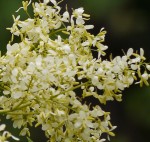 Flowering ash, also called California ash and two-petal ash, is a deciduous small tree or large shrub native California, northwestern Arizona, southern Nevada, Utah and norther Baja California where it frequently grows on dry shaded slopes and streambanks. It is a member of the olive family, Oleaceae, that also includes jasmine, forsythia, and lilac. The light to dark green leaves are two to 7 ½ inches long and have three to seven broad, oval leaflets ½ to 2 ¾ inches long with serrated margins. Small white flowers are produced in fluffy pendulous panicles in spring. The flowers have two lobed petals, are fragrant, and give way to flat, winged fruits (samara) ¾’ to 1 ¼ inch long. Three species of swallowtails use flowering ash as a host plant so it is a good addition to a butterfly garden but also a nice choice for a patio where the fragrance can be enjoyed. It can also be used as a specimen, screen, and in woodland garden.
Flowering ash, also called California ash and two-petal ash, is a deciduous small tree or large shrub native California, northwestern Arizona, southern Nevada, Utah and norther Baja California where it frequently grows on dry shaded slopes and streambanks. It is a member of the olive family, Oleaceae, that also includes jasmine, forsythia, and lilac. The light to dark green leaves are two to 7 ½ inches long and have three to seven broad, oval leaflets ½ to 2 ¾ inches long with serrated margins. Small white flowers are produced in fluffy pendulous panicles in spring. The flowers have two lobed petals, are fragrant, and give way to flat, winged fruits (samara) ¾’ to 1 ¼ inch long. Three species of swallowtails use flowering ash as a host plant so it is a good addition to a butterfly garden but also a nice choice for a patio where the fragrance can be enjoyed. It can also be used as a specimen, screen, and in woodland garden.
Type: Deciduous small tree or large shrub
Outstanding Feature: Flowers
Form: Broadly conical
Growth Rate: Rapid
Bloom: Small, fragrant, white flowers with two lobed petals in fluffy pendulous panicles in spring.
Size: 20-50’ H x 15-30’ W
Light: Full sun to light shade
Soil: Average, moist to dry, well-drained; tolerates occasional flooding and drought
Hardiness: Zones 7-10
Care: Low maintenance
Pests and Diseases: Scale, root rot, sooty mold, and Verticillium, Emerald ash borer (but not an issue in its native range at this time)
Propagation: Seed with three months stratification